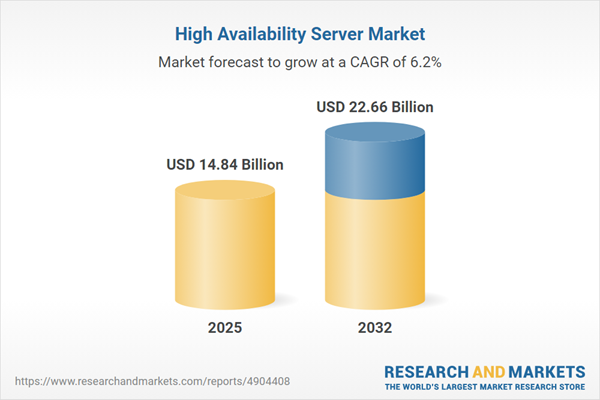Speak directly to the analyst to clarify any post sales queries you may have.
High availability server solutions are central to operational continuity strategies for enterprises across technology-driven sectors. This report equips senior leaders with the insight needed to steer investments in resilient infrastructure that minimizes downtime risk and aligns with evolving business objectives.
Market Snapshot: High Availability Server Market Overview
The high availability server market grew from USD 14.02 billion in 2024 to USD 14.84 billion in 2025. It is projected to continue expanding at a CAGR of 6.18%, ultimately reaching USD 22.66 billion by 2032. Solutions support always-on critical applications and underpin business resilience strategies.
Scope & Segmentation: Comprehensive Coverage
- Component: Hardware (blade, rack, tower servers), Services, Software (clustering, failover, replication)
- Architecture: Active-active, active-passive configurations address specific business continuity needs
- Availability Level: 99.000 %, 99.900 %, and 99.999 % uptime standards provide a range of protection targets
- Deployment: Cloud (hybrid cloud, private cloud, public cloud), On-premises
- End-User Industry: Banking, financial services & insurance; energy & utilities; government & defense; healthcare & life sciences; IT & telecom; manufacturing; media & entertainment; transportation & logistics
- Geographic Regions: Americas (United States, Canada, Mexico, Brazil, Argentina, Chile, Colombia, Peru), Europe, Middle East & Africa (UK, Germany, France, Russia, Italy, Spain, Netherlands, Sweden, Poland, Switzerland, United Arab Emirates, Saudi Arabia, Qatar, Turkey, Israel, South Africa, Nigeria, Egypt, Kenya), Asia-Pacific (China, India, Japan, Australia, South Korea, Indonesia, Thailand, Malaysia, Singapore, Taiwan)
- Key Companies: Hewlett Packard Enterprise, Dell Technologies, Alibaba Group Holding, Amazon Web Services, ASUSTek Computer, Atos Group, CenterServ International, Cisco Systems, Fujitsu, GIGA-BYTE Technology, Google (Alphabet), Hitachi Vantara, Huawei Technologies, Inspur, IBM, Jabil, Lenovo, Microsoft, MITAC Holdings, NEC, Nutanix, Oracle, Penguin Solutions, Progress Software, Quanta Computer, Super Micro Computer, Tencent Cloud, Unisys, Veritas Technologies (Cohesity), VMware (Broadcom), OSNEXUS
Key Takeaways: Strategic Insights for Decision-Makers
- Organizations must balance technical resilience priorities with cost control and operational continuity, particularly as workload demands evolve.
- The rise of software-defined resilience and hybrid deployments is reshaping decision frameworks and procurement models for high availability.
- Integration of observability and automated failover technologies is streamlining incident response while delivering more consistent recovery performance.
- Managed services and professional integration are increasingly preferred as enterprises look to outsource complexity and ensure end-to-end resilience outcomes.
- Vendor evaluation now centers on interoperability, delivery capabilities across deployment types, and accommodations for compliance and governance requirements.
- Strategic segmentation by organization size, deployment model, and industry vertical enables tailored, targeted investment in high availability infrastructure.
Tariff Impact: Navigating Supply Chain and Sourcing Risk
Recent tariff changes have increased complexity for sourcing high availability server hardware and components. Enterprises are diversifying suppliers, lengthening procurement cycles, and renegotiating contractual terms to minimize supply chain and cost volatility. Manufacturers are responding by qualifying additional suppliers and shifting production to mitigate operational risks, while end-users reinforce procurement safeguards and lifecycle protections.
Research Methodology & Data Sources
This analysis employs structured interviews with procurement leaders, technical experts, and service providers, combined with a review of technical documentation, regulatory guidance, and industry benchmarks. Scenario-based stress testing and capability mapping validate findings under practical deployment conditions.
Why This Report Matters: Actionable Advantages
- Benchmark architecture and supplier strategies to strengthen resilience against disruptions and regulatory change.
- Identify priority solution attributes for your organization’s size, vertical, and deployment model, ensuring investments align with actual business continuity needs.
- Gain visibility into sourcing, integration, and lifecycle management best practices directly impacting cost control and uptime objectives.
Conclusion
This report provides clarity on resilient high availability server strategies, supporting executives in aligning technology investments with operational continuity and risk reduction priorities.
Additional Product Information:
- Purchase of this report includes 1 year online access with quarterly updates.
- This report can be updated on request. Please contact our Customer Experience team using the Ask a Question widget on our website.
Table of Contents
3. Executive Summary
4. Market Overview
7. Cumulative Impact of Artificial Intelligence 2025
Companies Mentioned
The companies profiled in this High Availability Server market report include:- Hewlett Packard Enterprise Company
- Dell Technologies Inc.
- Alibaba Group Holding Limited
- Amazon Web Services, Inc.
- ASUSTek Computer Inc.
- Atos Group
- CenterServ International, Ltd.
- Cisco Systems, Inc.
- Fujitsu Limited
- GIGA-BYTE Technology Co., Ltd.
- Google LLC by Alphabet Inc.
- Hitachi Vantara LLC
- Huawei Technologies Co., Ltd.
- Inspur Electronic Information Industry Co., Ltd.
- International Business Machines Corporation
- Jabil Inc.
- Lenovo Group Limited
- Microsoft Corporation
- MITAC HOLDINGS CORPORATION
- NEC Corporation
- Nutanix, Inc.
- Oracle Corporation
- Penguin Solutions, Inc.
- Progress Software Corporation
- Quanta Computer Inc.
- Super Micro Computer, Inc.
- Tencent Cloud Europe B.V.
- Unisys Corporation
- Veritas Technologies LLC by Cohesity
- VMware by Broadcom Inc.
- OSNEXUS Corporation
Table Information
| Report Attribute | Details |
|---|---|
| No. of Pages | 185 |
| Published | October 2025 |
| Forecast Period | 2025 - 2032 |
| Estimated Market Value ( USD | $ 14.84 Billion |
| Forecasted Market Value ( USD | $ 22.66 Billion |
| Compound Annual Growth Rate | 6.1% |
| Regions Covered | Global |
| No. of Companies Mentioned | 32 |









